Study on thermal-state variation of high-grade highway embankment under different pavement conditions
QingZhi Wang ,AnHua Xu ,KeJin Wang
1.School of Civil Engineering,Qinghai University,Xining,Qinghai810016,China
2.Qinghai Communications Technical College,Xining,Qinghai810016,China
3.Qinghai Transportation Holding Group Co.LTD,Xining,Qinghai810016,China
ABSTRACT The research shows that the selection of pavement type is very important for the thermal stability of high-grade highway embankment in permafrost regions because of the different solar absorption rates between asphalt concrete and asphalt concrete pavement.In this paper,the common embankment of high-grade highway in permafrost regions is selected as the research object to study the influence of asphalt concrete and cement concrete pavement on the embankment temperature,freeze-thaw cycle process and the change law of the permafrost table,which provides a basis for the use of reasonable pavement materials in permafrost regions.
Keywords:high-grade highway embankment;pavement;thermal-state;permafrost table
1 Introduction
Permafrost degradation has a great impact on the construction and operation management of high-grade highways in Qinghai-Tibet Plateau.The thermal and mechanical stability of embankment engineering and the interaction with permafrost environment need at‐tention and maintenance(Zhou et al.,2000).Howev‐er,in high-temperature permafrost regions that are particularly sensitive to thermal disturbances,the high temperature of permafrost close to 0℃and continu‐ous heat accumulation under embankment will cause continuous melting of permafrost(Sheng et al.,2002).Among the highway engineering elements,pavement type is an important factor affecting the thermal stability of embankment in permafrost region of Qinghai-Tibet Plateau(Feng et al.,2011;Si et al.,2012;Zhang et al.,2015;Ke et al.,2019).The type of pavement has a direct impact on the heat balance of embankment.Compared with the representative black asphalt concrete pavement and light-colored cement concrete pavement,the absorption rate of solar radia‐tion of asphalt concrete pavement is as high as 0.95,while that of cement concrete pavement is about 0.65.The gravel pavement was used in the initial stage of Qinghai-Tibet Highway,and there were no more dis‐eases in the embankment.After reconstruction and asphalt pavement,the permafrost table under the em‐bankment decreased continuously,and the uneven settlement of the embankment developed seriously.The high-speed and high-strength pavement has led to a large number of embankment diseases.There are two main reasons:firstly,the strong heat absorption of asphalt pavement changes the original thermal sta‐bility of embankment system;secondly,the sealing effect of asphalt pavement prevents convective heat transfer and prevents water from evaporating from the interior of pavement,which reduces the evapora‐tion heat consumption of embankment and greatly changes the original water-heat balance state of em‐bankment system.Cement pavement has low heat absorption effect and high strength,which can sig‐nificantly improve the temperature field inside the embankment and improve the stability of the em‐bankment.However,it has high requirements for construction,health preservation and other condi‐tions,which is difficult to meet in Qinghai-Tibet Pla‐teau region,resulting in the easy destruction of pave‐ment(Zhang et al.,2011;Zhu et al.,2014;Zhang et al.,2015).Therefore,cement concrete pavement is rarely used in permafrost regions of Qinghai-Tibet Plateau.
In summary,when selecting pavement types in permafrost regions of Qinghai-Tibet Plateau,various factors such as pavement reflectivity,pavement strength,pavement damage,pavement construction and maintenance conditions should be comprehensive‐ly considered and finally determined.Therefore,this paper selects high-grade highway embankment in per‐mafrost regions as the research object to study the in‐fluence of asphalt concrete and cement concrete pave‐ment on embankment temperature,freeze-thaw cycle process and the change law of permafrost table,which provides a basis for the use of reasonable pavement materials in permafrost regions.
2 Observation site
Qinghai Research and Observation Base(Qing‐hai Permafrost Research and Observation Base),the Key Laboratory of Highway Construction and Main‐tenance Technology in Permafrost Regions is located at Huashixia Town,Maduo Country,K444+500 along the Gonghe-Yushu High-grade Highway,as shown in Figure 1 and the geographic coordinates are 98°34′05"E,34°58′28"N,with 4,260 m average elevation,and the annual average temperature is−3℃.The permafrost table is nearly−2.0 m in depth,below which there is ice-rich permafrost.The aver‐age annual ground temperature ranges from−1.0 to−0.5.This warm and ice-rich permafrost condition is typical in the majority route of Gonghe-Yushu Highgrade Highway and is troublesome for engineering infrastructures.
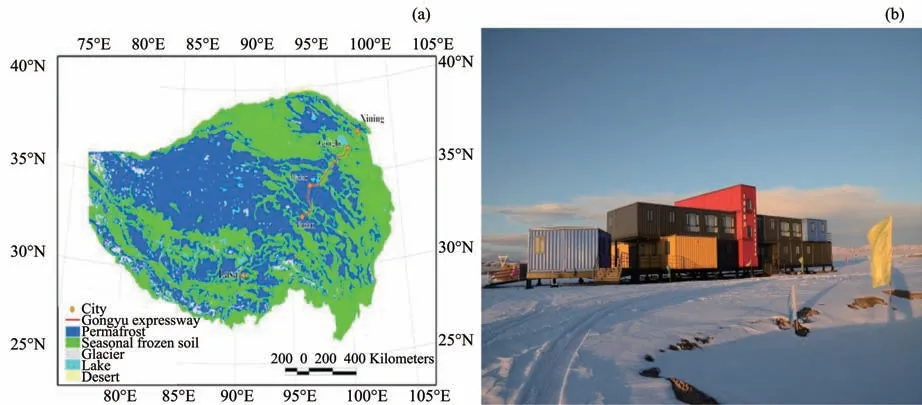
Figure 1 The geographical location of Study and Observation Base of Permafrost in Qinghai(Wang et al.,2020)
The live photos of high-grade highway embank‐ment in Qinghai Frozen Soil Research and Observa‐tion Base are shown in Figure 2.The embankment runs from east to west,with a height of 2.5 m,a slope gradient of 1:2,a pavement width of 12.25 m and an embankment length of 60 m.
The embankment is paved with asphalt and ce‐ment concrete pavement,the upper filler of the em‐bankment is coarse grained soil,and 30 cm gravel fil‐ter,filter layer and geotextile are paved,as shown in Figure 3.
In order to monitor the temperature characteristics of the High-grade highway embankment,five temper‐ature measuring holes are set up in each section.As shown in Figure 4,the depth of the central hole of the embankment is 20 m,the depth of the left and right embankment shoulder holes is 15 m,the depth of the left and right slope toe holes is 10 m,and another nat‐ural hole is set up.The hole depth is 20 m at the place 20 m away from the foot of the embankment slope and where there is no human disturbance.A tempera‐ture probe is arranged at a distance of 0.5 m or 1 m from the surface of the temperature measuring hole along the depth direction,and the frequency of tem‐perature data acquisition is four times a day,and the time is 02:00,08:00,14:00,and 20:00 respectively.
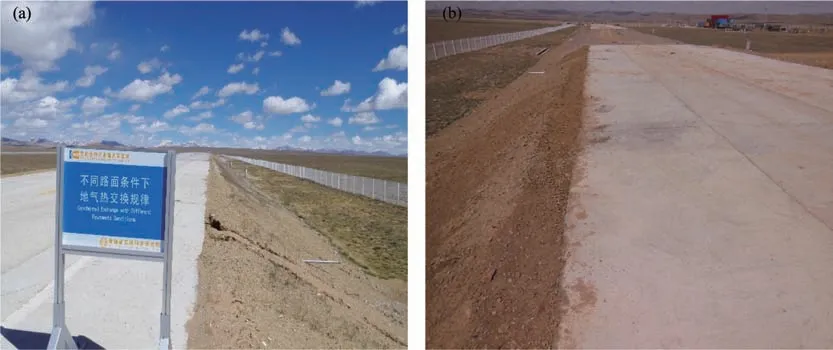
Figure 2 The High-grade highway embankment under different pavement

Figure 3 The High-grade highway embankment under asphalt and cement concrete pavement
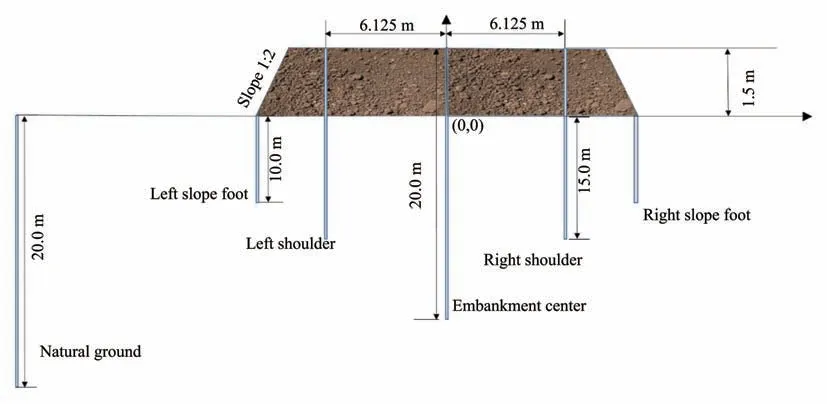
Figure 4 The embankment with temperature monitor
3 Result analysis
3.1 Temperature changes of shady-sunny embankment shoulders of embankment under different pavements
Figure 5 shows the change of temperature of Shady-sunny embankment shoulders at 0.5 m below the pavement of asphalt concrete and cement concrete pavement with time.It can be found that the annual change of ground temperature of Shady-sunny embank‐ment shoulders is also sinusoidal.The Shady-sunny embankment shoulders of embankment under asphalt concrete pavement reach the highest temperature from July to August every year,the highest tempera‐tures of Shady-shoulder are 9.75,10.67,10.46 and 12.21℃respectively from 2015 to 2018,and the highest temperatures of Sunny-shoulder are 11.47,10.42,14.59 and 11.72℃respectively from 2015 to 2018.The lowest temperature is reached from Janu‐ary to February every year.The lowest temperature of Shady-shoulder is 9.14,−9.69,−7.14 and−9.29℃from 2015 to 2018,and the lowest temperature of Sunny-shoulder is−6.79,−7.95,−7.4 and−8.65℃from 2015 to 2018.It is found that the difference be‐tween Shady-shoulder and Sunny-shoulder is obvious in cold season,and the temperature of Shady-shoulder is lower than that of Sunny-shoulder,but in warm sea‐son,the difference is not particularly obvious.Through sinusoidal fitting,the average temperature and variation range of Shady-sunny embankment shoulder temperature are obtained(Table 1).It can be seen that the average temperature of Sunny-shoulder(1.51℃)is greater than that of Shady-shoulder(0.71℃),but the variation range is not much differ‐ent,which is 9.03℃and 9.21℃respectively.For ce‐ment concrete pavement,the highest temperature and lowest temperature of Shady-sunny embankment shoulders are lower than those of asphalt concrete pavement,and the average temperature of Sunnyshoulder(1.35℃)is higher than that of Shady-shoul‐der(0.96℃),and the difference of change range is not particularly large,which is 10.91℃and 9.71℃respectively(Table 2).

Figure 5 The monitored temperature under 0.5 m from pavement
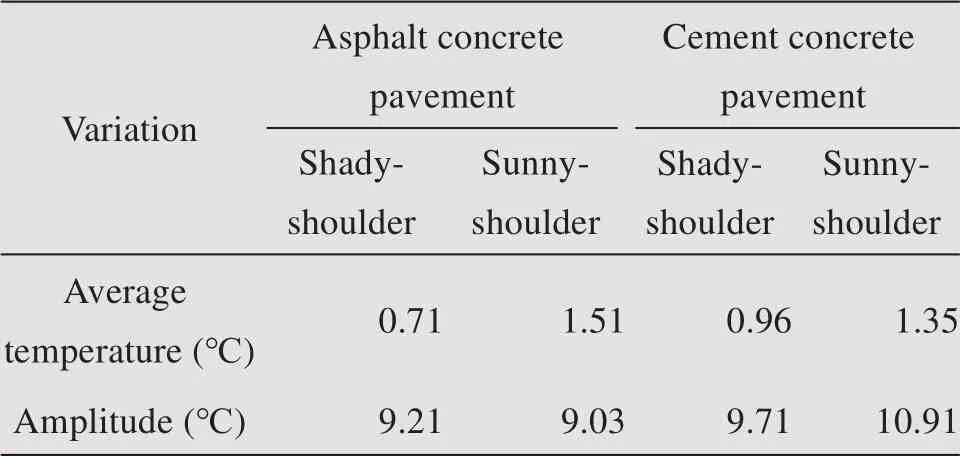
Table 1 The temperature under 0.5 m from pavement in shady-sunny shoulder
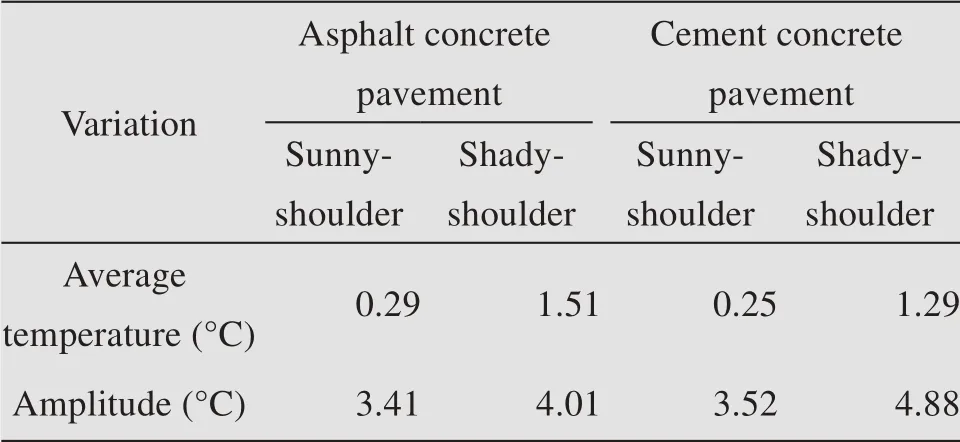
Table 2 The temperature under 0.5 m from pavement in shady-sunny shoulder
Figure 6 shows the change of the temperature of Shady-sunny embankment shoulders with time at 0.5 m below the original natural ground of the em‐bankment under asphalt concrete and cement con‐crete pavement.It can be found that the annual varia‐tion of ground temperature of Shady-sunny embank‐ment shoulders is also sinusoidal.Except for 2016,the difference between Shady-sunny embankment shoulders of embankment under asphalt concrete pavement is obvious in warm season and cold sea‐son.The maximum temperature difference between Shady-sunny embankment shoulders in warm sea‐son from 2015 to 2018 is 2.04,2.17,3.28 and 2.89℃respectively,and the maximum temperature difference between Shady-sunny embankment shoul‐ders in cold season from 2015 to 2018 is−1.89.Through sinusoidal fitting,the table obtains the av‐erage temperature and variation range of Shady-sun‐ny embankment shoulder temperature 0.5 m below the original ground.It can be seen that the average temperature of Sunny-shoulder(1.5℃)is greater than that of Shady-shoulder(0.29℃),but the varia‐tion range is not much different.Compared with as‐phalt concrete pavement,the temperature difference between Shady-sunny embankment shoulders of embankment under cement concrete pavement is relatively small,while the average temperature of Sunny-shoulder(1.29℃)is greater than that of Shady-shoulder(0.25℃),with the variation ranges of 4.88℃and 3.52℃respectively.Compared with asphalt concrete,the average temperature and varia‐tion range of embankment Shady-sunny embank‐ment shoulders under cement concrete pavement are relatively small.
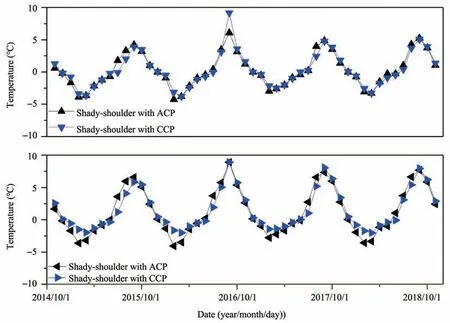
Figure 6 The monitored temperature under 0.5 m from natural ground
Figure 7 shows the change of Shady-sunny em‐bankment shoulder temperature with time at 5 m be‐low the original ground of embankment under as‐phalt concrete and cement concrete pavement,it can be found that the annual change of ground tem‐perature of Shady-sunny embankment shoulders is straight.The temperature range of Shady-sunny em‐bankment shoulders under asphalt concrete pave‐ment is between−0.47 to−0.55℃,and the tempera‐ture range of yang and Sunny-shoulders is between−0.41 to−0.42℃.Most of the time,the tempera‐ture of yang and Sunny-shoulders is greater than that of Shady-sunny embankment shoulders.And the Shady-sunny embankment shoulders are in the heating stage,with the heating rate of 3.1×10-5℃on the Yin slope and 4.42×10-5℃on the Yang slope.However,the heating rate of the Shady-shoul‐der of the embankment under the cement concrete pavement 5 m below the original pavement is 6.97×10-5℃/d,The heating rate of Sunny-shoulder is 0.92×10-5℃/d,which is higher than that of Shady-sunny embankment shoulders of embank‐ment under asphalt concrete pavement,but the tem‐perature range of Shady-sunny embankment shoul‐ders of embankment under cement concrete pave‐ment is between−0.60 to−0.50℃and that of Yang slope embankment is between−0.55 to−0.40℃,which is lower than that of Shady-sunny embank‐ment shoulders of ordinary embankment under as‐ phalt concrete pavement.

Figure 7 The monitored temperature under 5.5 m from natural ground
Figure 8 shows the annual average temperature of the temperature shady-sunny shoulder under as‐phalt concrete pavement varying with the depth.The average temperature of the permafrost is−0.79 to−0.81°C,which is classified as warm permafrost.It can be seen from the figure that from 2015 to 2018,the temperature at the same depth is significantly higher on sunny shoulder than on shady shoulder.The results show that the temperature difference be‐tween the upper parts is larger,and the difference be‐comes smaller with the increase of the depth,which indicates that the difference of heat exchange be‐tween the two sides leads to the difference of perma‐frost temperature in the lower part of the shoulder,and this effect gradually weakens from shallow to deep.
Figure 9 shows the annual average temperature of the temperature shady-sunny shoulder under cement concrete pavement varying with the depth.Compared with Figure 8,it can be concluded that from 2015 to 2018,the external atmospheric temperature has a greater,more penetrating influence on the tempera‐ture field of the block-stone embankment constructed with asphalt concrete pavement than with cement con‐crete pavement.
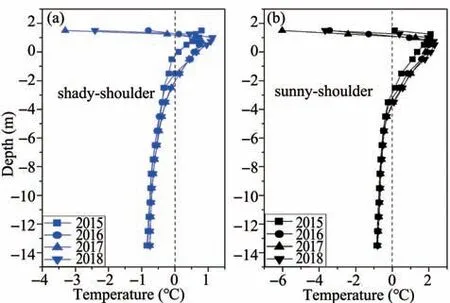
Figure 8 Variation of annual mean temperature with depth on shoulder of shady-sunny shoulder under asphalt concrete pavement
3.2 Comparison of embankmentbed freeze-thaw cycle process under different pavements
Figure 8 shows the freeze-thaw cycle process of embankment center under asphalt concrete pavement.In the figure,the depth of 0 m is the original ground and the embankment height is 1.5 m.Under the central hole of embankment,the melting period within one year is obviously longer than the freezing period,and no obvious melting interlayer is formed,that is,the fro‐zen soil in cold season can be completely connected in the vertical direction.The seasonal melting depth un‐der the embankment center can reach−4.58 to−5.46 m.

Figure 8 Freeze-thaw cycle process of embankment center under asphalt concrete pavement
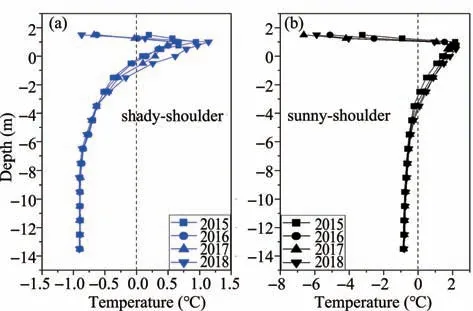
Figure 9 Variation of annual mean temperature with depth on shoulder of shady-sunny shoulder under cement concrete pavement
Asshown in Figure10,from thecomparison of freezethaw cycle processes of embankment Shady-shoulders under different pavements,the freezing and thaw‐ing times are inconsistent,but no obvious thawing interlayer is formed.The seasonal thawing depth of embankment Shady-shoulders under asphalt con‐crete pavement can reach−3.5 to−4.17 m,while un‐der cement concrete pavement,the value is−3.49 to−4.2 m,with little difference,but both have a gradu‐ally increasing trend.
As shown in Figure 11,from the comparison of freeze-thaw cycle processes of embankment Sunny-shoulders under different pavements,the freez‐ing and thawing times are inconsistent,but no obvi‐ous thawing interlayer is formed.The seasonal thaw‐ing depth of embankment Sunny-shoulders under as‐phalt concrete pavement can reach−4.73 to−5.67 m,while under cement concrete pavement,the value is−4.74 to−5.7 m,with little difference,but both have a gradually increasing trend.
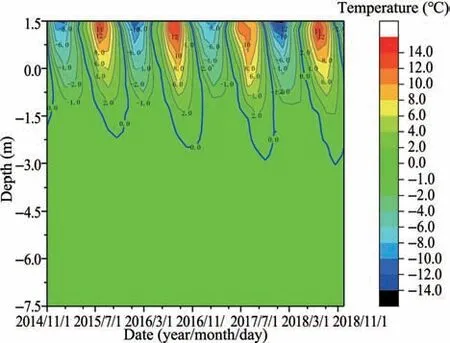
Figure 9 Freeze-thaw cycle process of embankment center under cement concrete pavement
3.3 Comparison of permafrost table of embankment under different pavements
Figure 12 shows the change of the permafrost ta‐ble in the center of embankment under asphalt con‐crete pavement,moving down from−4.58 m in 2015 to−5.46 m in 2018,indicating that the perma‐frost table thickness is increasing,i.e.,the perma‐frost in the center of embankment is degenerating with a degradation rate of 28.0 cm/a,as shown in Figure 13.
Under asphalt concrete pavement,the artificial permafrost table on the Shady-sunny embankment shoulders of the embankment is also in a continuous process of increasing.However,due to the Shady-sun‐ny effects of the embankment,the surface temperature on the left and right sides of the embankment is quite different,which leads to the increase rate of the perma‐frost table thickness of frozen soil on the Shady-sunny embankment shoulders,that is,the degradation rate of permafrost is different.Taking the permafrost table on the Shady-shoulder(left embankment shoulder)of as‐phalt concrete pavement as an example,it decreased from−3.5 m in 2015 to−4.17 m in 2018,and the deg‐radation rate of permafrost was 0.21 m/a,while that on the Sunny-shoulder(right embankment shoulder)de‐creased from−4.73 m to−5.67 m,and the degradation rate of permafrost was0.32 m/a.
As shown in Figure 14,the permafrost table in the center of embankment under cement concrete pave‐ment decreased from−3.69 m in 2015 to−4.54 m in 2018,and the growth rate of the permafrost table thickness of frozen soil was 31.0 cm/a.Compared with asphalt concrete pavement,the increase rate of permafrost table in embankment center under cement concrete pavement has little difference.
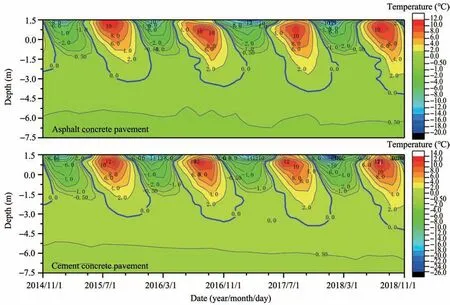
Figure 10 Comparison of freeze-thaw cycle process of shady-sunny shoulder
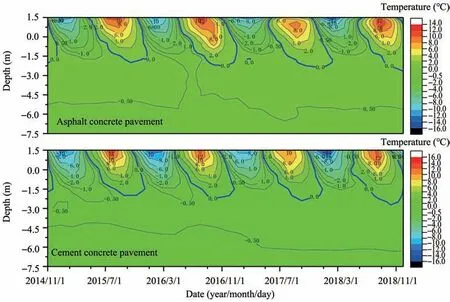
Figure 11 Comparison of freeze-thaw cycle processes on sunny-shoulder shoulder of embankment
As shown in Figure 15,under the cement con‐crete pavement,the Shady-shoulder(left embank‐ment shoulder)of the embankment decreased from−3.49 m in 2015 to−4.2 m in 2018,and the perma‐frost degradation rate was 0.23 m/a,while the Sunny-shoulder (right embankment shoulder)decreased from−4.74 m to−5.70 m,and the permafrost degradation rate was 0.33 m/a(Table 3).There is little difference between the degrada‐tion rate of frozen soil and that of asphalt concrete pavement at the same location under the same conditions.
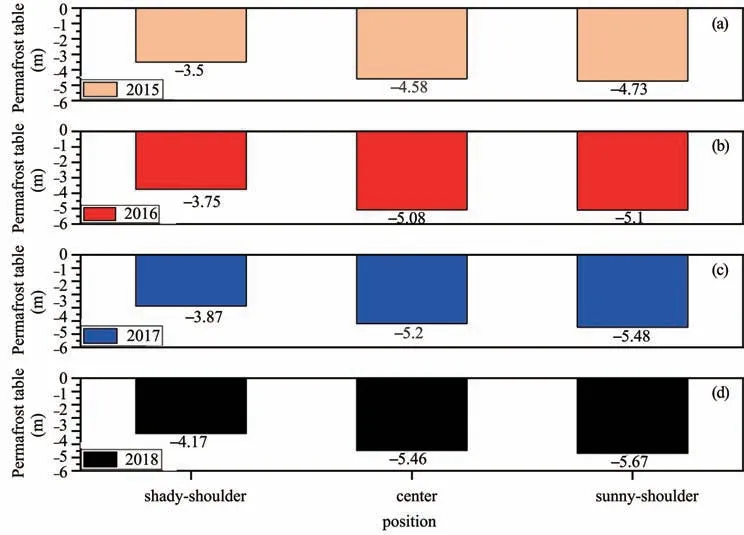
Figure 12 Permafrost table of embankment under asphalt concrete pavement

Figure 13 Degradation of permafrost table of subgrade under asphalt concrete pavement
4 Conclusions
Whether it is asphalt concrete pavement or ce‐ment concrete pavement,the temperature differ‐ence between Shady-sunny embankment shoulders of embankment is obvious in cold season,but small in warm season.The average temperature of Sunny-shoulder is higher than that of Shady-shoulder,but the change range is not much different.At 0.5 m below the pavement and 0.5 m below the original natural ground,the highest temperature and lowest temperature of the Shady-sunny embankment shoul‐ders of the embankment under the cement concrete pavement are lower than those of the asphalt con‐crete pavement.However,at 5.5 m below the origi‐nal natural ground,the heating rate of embankment Shady-sunny embankment shoulders under cement concrete pavement is higher than that of ordinary em‐bankment Shady-sunny embankment shoulders under asphalt concrete pavement,but the temperature varia‐tion range is smaller than that of asphalt concrete pavement.

Table 3 Permafrost degradation rate

Figure 12 Permafrost table of embankment under cement concrete pavement
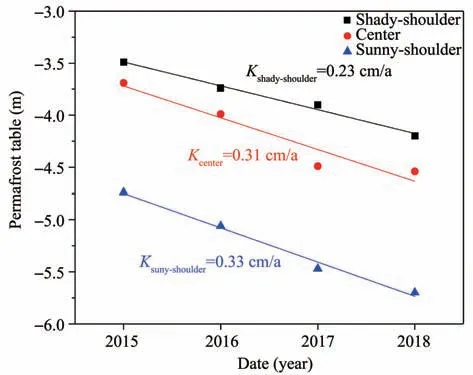
Figure 15 Degradation of permafrost table of subgrade under cement concrete pavement
Whether it is asphalt concrete pavement or ce‐ment concrete pavement,the melting period of em‐bankment within one year is obviously longer than the freezing period,and no obvious melting interlay‐er is formed,and the permafrost table tends to in‐crease gradually.Compared with asphalt concrete pavement,there is little difference in the increase rate of permafrost table in embankment center and Shady-sunny embankment shoulders under cement concrete pavement.However,the increase rate of the permafrost table on Sunny-shoulder is greater than that on Shady-shoulder.
Acknowledgments:This work is supported by the National Natural Science Foundation of China(Nots.41801046,42161026),the Natural Science Foundation of Qing‐hai Province(No.2021-ZJ-716),the Transportation Science and Technology Project of Qinghai Prov‐ince(No.2019-06&No.2018-02).
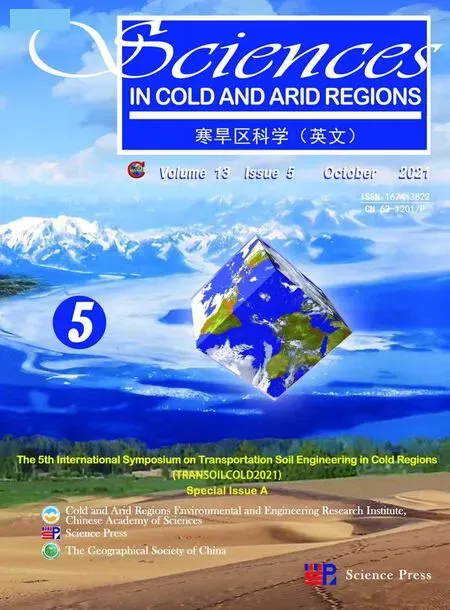 Sciences in Cold and Arid Regions2021年5期
Sciences in Cold and Arid Regions2021年5期
- Sciences in Cold and Arid Regions的其它文章
- Study on mechanical properties of soil-rock mixture of various compactness subjected to freeze-thaw cycles
- Strength characteristics and energy dissipation evolution of thawing silty clay during cyclic triaxial loading
- Impact of brine on physical properties of saline soils
- Field monitoring of differential frost heave in widened highway subgrade
- Numerical simulation of electroosmosis in unsaturated compacted clay
- Study on tensile damage characteristicsof sandstone under freeze-thaw cycles
